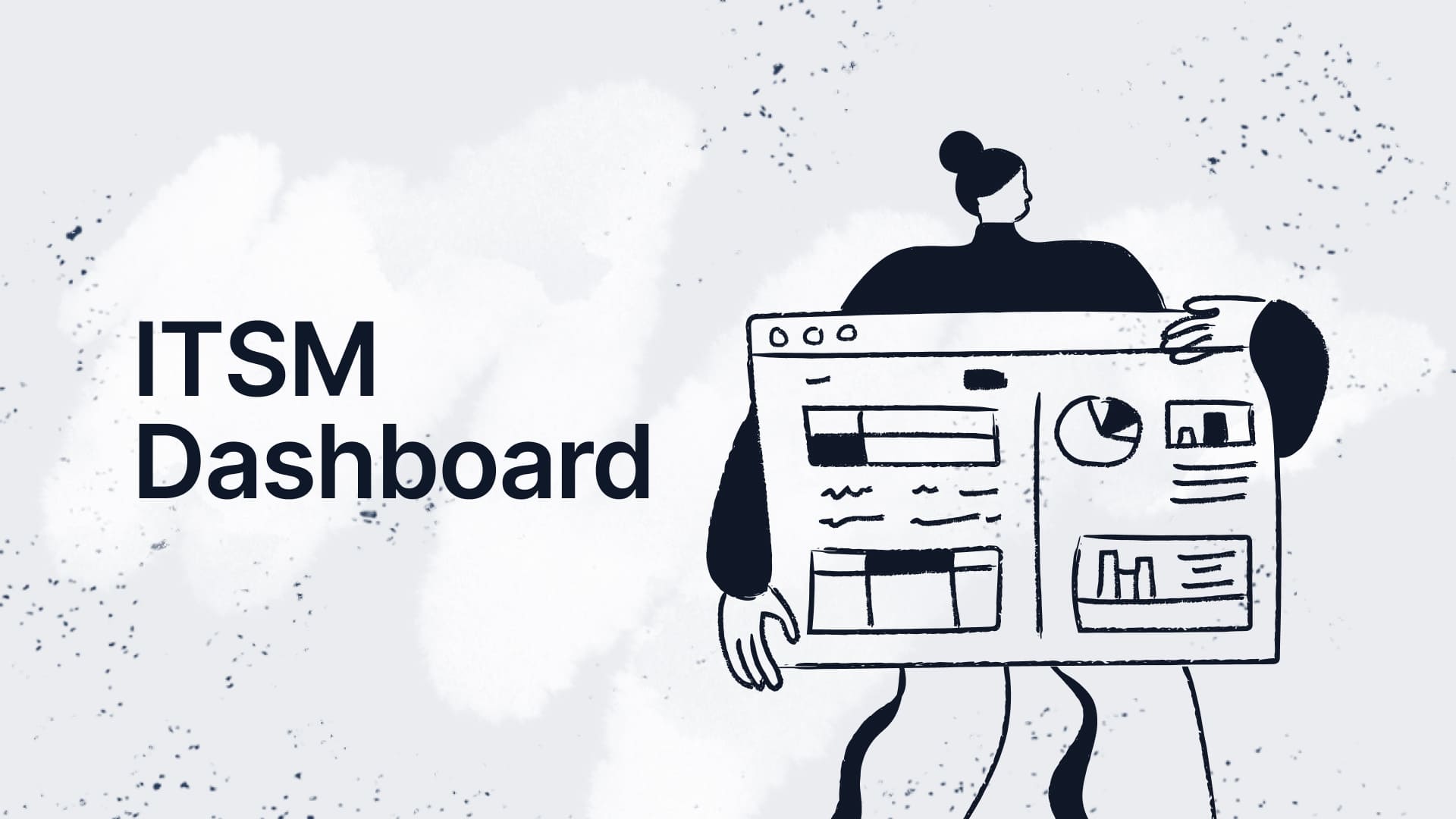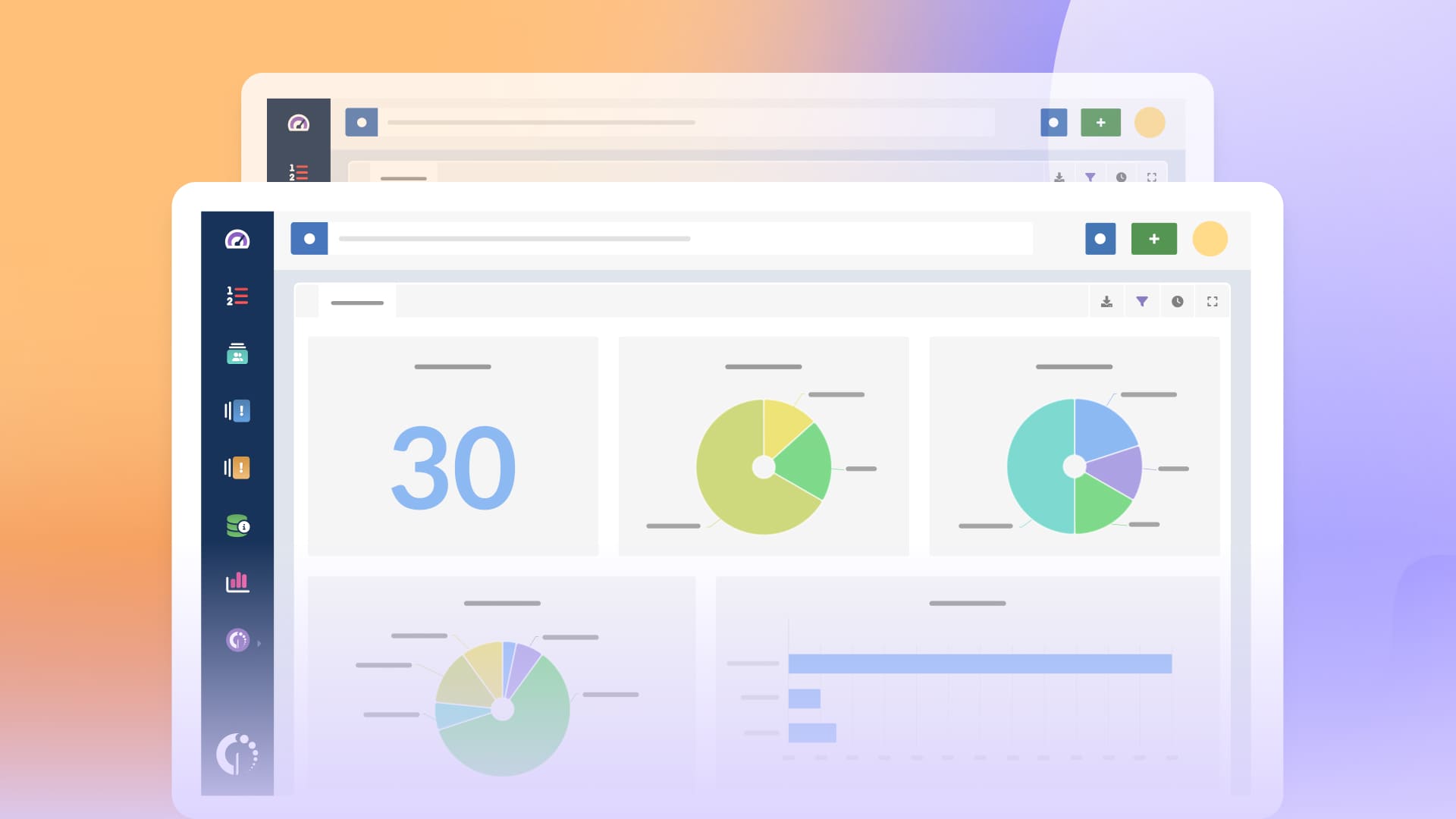IT Service Management (ITSM) has become integral to the success of many organizations. It allows businesses to streamline processes, enhance self-service options and customer satisfaction, and improve operational efficiency. However, to fully reap the benefits of ITSM, it’s crucial to track performance — and that’s where ITSM metrics come into play.
By using the right ITSM metrics, you can evaluate how well your IT services align with business objectives and customer expectations. Metrics provide valuable insights into areas like service availability, and customer satisfaction, offering a roadmap for continuous improvement.
In this article, we’ll guide you through the top IT Service Management metrics to track performance, offering tips on how to choose the right ones and breaking down metrics by specific ITSM practices.
Keep reading to find out which metrics should be on your radar!
Our top 10 ITSM metrics selection
Here are our top 10 ITSM metrics that can help track and improve IT service performance:
-
Incident Resolution Time: Measures how long it takes to resolve an incident from the time it’s reported. It’s crucial for minimizing downtime and ensuring quick service restoration. Fast incident resolution contributes to business continuity by reducing disruptions and restoring normal operations swiftly, ensuring minimal impact on customers and employees.
-
First Contact Resolution Rate: Tracks the percentage of incidents resolved during the first interaction, improving customer satisfaction and operational efficiency. High first contact resolution rates mean fewer escalations, lower costs, and improved user satisfaction since problems are dealt with promptly without the need for multiple follow-ups.
-
Service Availability: Monitors the uptime of critical services, ensuring that essential systems remain accessible to users and that disruptions are minimized. Maintaining high service availability is key to business operations as it helps avoid costly downtime, keeps services operational, and directly impacts the user experience.
-
Customer Satisfaction (CSAT) Score: Evaluates how satisfied users are with the IT service they receive, often through surveys after an issue is resolved. A high CSAT score indicates that the service desk and IT teams are meeting or exceeding user expectations, which is a strong indicator of overall service quality and efficiency.
-
Change Success Rate: Measures the percentage of changes successfully implemented without causing service disruption, crucial for maintaining service quality. A higher success rate shows that changes are being planned, tested, and executed effectively, minimizing the risk of service interruptions and ensuring smooth transitions.
-
Service Request Volume: Tracks the total number of service requests, offering insight into workload and resource management for the IT team. Understanding service request volume helps IT teams allocate resources effectively and prioritize tasks, ensuring that critical requests are handled in a timely manner.
-
SLA Compliance Rate: Measures how often the service meets the agreed-upon Service Level Agreement (SLA) targets, ensuring business expectations are met. Monitoring SLA compliance ensures that services are delivered in line with agreed-upon performance standards, helping to build trust with stakeholders and users.
-
Incident Response Time: Calculates how quickly IT teams respond to reported incidents, impacting both service quality and user satisfaction. Faster response times are essential for maintaining user confidence and minimizing the time incidents affect business operations.
-
Problem Resolution Time: Tracks how long it takes to resolve underlying problems, which is essential for minimizing recurring incidents. Addressing the root cause of issues prevents them from resurfacing, improving long-term service stability and reducing the overall number of incidents.
-
Help Desk Efficiency: Evaluates how efficiently the service desk handles incoming requests, helping identify areas for process improvements and resource allocation. A more efficient help desk can resolve tickets faster, reduce costs, and provide better user experiences by streamlining service processes.

What are ITSM metrics?
IT Service Management metrics are measurable indicators used to assess the performance of ITSM processes. These metrics help organizations evaluate how effectively their IT services support business operations and customer needs.
ITSM metrics serve as the backbone for assessing the success and efficiency of various IT activities, offering quantifiable insights that allow for continuous improvement.
They can be divided into categories based on specific ITSM practices, such as Incident Management, Problem Management, and Change Management. This segmentation allows IT leaders to focus on specific aspects of service delivery, helping to refine processes and enhance performance in targeted areas.

Why are ITSM metrics important?
ITSM metrics are critical for several reasons. First, they help IT leaders and teams assess whether their services meet business and customer expectations. Metrics provide a quantitative basis for informed decisions, allowing organizations to identify bottlenecks, improve efficiency, and ensure that IT services align with overall business goals.
Moreover, they foster continuous improvement by enabling teams to track trends over time and make data-driven adjustments. Below are five key reasons why ITSM metrics are essential.
1. Ensure service quality
ITSM metrics provide insight into how well services are delivered, ensuring that service quality remains consistent and meets defined standards. By monitoring these metrics, IT teams can quickly identify and correct any deviations from expected performance levels, maintaining a high standard of service delivery.
2. Enhance customer satisfaction
By monitoring metrics like first contact resolution rate and customer satisfaction scores, IT teams can directly measure how satisfied users are with the service they receive. Higher satisfaction levels indicate that the IT team is effectively addressing user needs, leading to stronger relationships between IT and other business functions.
3. Help minimize downtime
Tracking metrics like incident resolution time and service availability helps reduce the time systems are offline, leading to improved business continuity. Minimizing downtime is critical for ensuring that business operations continue uninterrupted, safeguarding productivity and revenue.
4. Align IT with business goals
Metrics like SLA compliance rate and service request volume help ensure IT services are supporting broader business objectives, rather than just technical goals. When IT services are aligned with business priorities, it leads to better resource allocation, higher productivity, and greater overall business success.
5. Enable data-driven decisions
With real-time metrics at hand, IT leaders can make decisions based on concrete data, leading to better resource management and process optimization. Data-driven insights provide a clear picture of what’s working and what’s not, allowing teams to focus their efforts on areas that will deliver the greatest impact.

Guidelines for choosing metrics and KPIs
Choosing the right metrics and KPIs is vital for measuring ITSM performance effectively. Here are some recommendations.
1. Align metrics with business goals
Select metrics that directly support your organization’s business objectives, such as improving customer satisfaction or reducing downtime. Metrics should not only measure IT performance but also demonstrate how IT services contribute to the overall success of the business.
2. Focus on actionable data
Choose metrics that provide insights you can act on. Avoid tracking too many metrics, which can dilute focus. The best metrics are those that lead to tangible improvements in service delivery, helping IT teams make meaningful changes to their processes.
3. Balance efficiency and effectiveness
Metrics should not only track how quickly tasks are completed but also how well they meet quality and customer satisfaction standards. Balancing speed with quality ensures that IT services are both efficient and effective, meeting the needs of the business without sacrificing service quality.
4. Prioritize customer experience
Consider metrics like customer satisfaction score and first contact resolution rate, which are directly tied to user satisfaction and experience. Enhancing customer experience is a key objective for many IT teams, and tracking relevant metrics ensures that this priority is always at the forefront of service delivery.
5. Continuously review and adjust
Metrics should evolve with your business. Regularly review your KPIs to ensure they remain relevant and aligned with changing business priorities. As business objectives and technologies change, so too should the metrics used to measure IT service performance.

25 key IT Service Management metrics to track performance
To give you a clearer view of how to track ITSM performance, we’ve divided the key metrics by ITSM practices.
This structure ensures that metrics are aligned with the specific goals of each area, making it easier to optimize performance and focus on the most impactful aspects of Service Management.
Incident Management metrics
1. Incident Resolution Time
Measures how long it takes to resolve an incident after it’s reported. This metric is essential for minimizing business downtime. The faster incidents are resolved, the less impact they have on operations, customer satisfaction, and overall business continuity.
2. First Contact Resolution Rate
Tracks the percentage of incidents resolved during the first interaction. High rates of first contact resolution lead to quicker problem-solving, which improves user satisfaction and reduces pressure on higher-level IT support.

3. Incident Response Time
Calculates the average time taken to respond to a reported incident. A fast response time is critical to ensuring that small issues are addressed before they escalate into larger problems that could affect business operations or customer experience.
4. Incidents Resolved per Agent
Evaluates how many incidents each IT agent resolves in a specific time frame. This metric helps assess agent productivity and can reveal whether workload is distributed efficiently across the team.
5. Incident Reopen Rate
Monitors the percentage of incidents that are reopened after being marked resolved. A high reopen rate indicates that incidents weren’t fully addressed the first time, leading to inefficiencies and reduced customer satisfaction.

Problem Management metrics
6. Problem Resolution Time
Measures how long it takes to resolve the root cause of incidents. Problem Management goes beyond fixing immediate issues by addressing underlying problems to prevent future incidents. Quick resolution time indicates an efficient process in place for resolving long-term issues.
7. Problems Detected Proactively
Tracks the number of problems identified before they result in incidents. This metric is crucial for improving IT stability and performance since proactive problem detection helps prevent service disruptions and improves customer satisfaction.
8. Problem Recurrence Rate
Measures how often the same problem reoccurs after it has been “resolved.” A low recurrence rate indicates that the root causes of problems are being effectively addressed, preventing future disruptions and reducing overall incident volume.
9. Problems Pending for a Long Time
Assesses the number of problems that remain unresolved for extended periods. A high number of lingering problems can indicate inefficiencies in the Problem Management process or a need for additional resources to resolve more complex issues.
10. Root Cause Analysis Completion Time
Tracks the time it takes to complete Root Cause Analysis (RCA) after a problem is identified. The faster the root cause is determined, the quicker the problem can be resolved, helping to prevent similar incidents in the future.
Service Level Agreement (SLA) metrics
11. SLA Compliance Rate
Measures the percentage of services that meet the performance targets outlined in their SLAs. Maintaining high SLA compliance is critical for building trust with users and ensuring that IT services meet business expectations.
12. SLA Breach Rate
Tracks the number of times SLAs are breached. A low breach rate reflects the reliability of IT services and ensures that service providers are consistently meeting agreed-upon expectations for response and resolution times.

13. Service Uptime
Monitors the percentage of time a service is operational and accessible. High service uptime is crucial for keeping critical business operations running smoothly and ensuring minimal service disruption for users.
14. Time to Restore Service after SLA Breach
Measures how long it takes to restore a service after an SLA has been breached. This metric is important for understanding the organization’s capability to address service failures quickly, even when performance expectations aren’t initially met.
15. SLA Resolution Time
Tracks the time it takes to resolve a service request or incident within the agreed SLA timeframe. Ensuring resolution within SLA parameters demonstrates an IT organization’s commitment to meeting business objectives and delivering quality service.

Change Management metrics
16. Change Success Rate
Measures the percentage of successful changes made without causing incidents or service disruptions. High success rates suggest that changes are well-planned and executed, leading to smoother service transitions.
17. Change Failure Rate
Tracks the number of changes that result in incidents or service interruptions. A lower failure rate indicates that Change Management processes are robust and that changes are thoroughly tested before implementation.
18. Emergency Change Percentage
Monitors the proportion of emergency changes, highlighting whether IT is proactively managing risks or frequently reacting to unforeseen issues. A lower percentage suggests that most changes are planned rather than reactive.
19. Time to Implement a Change
Evaluates the time taken to implement a change after it has been approved. Shorter implementation times suggest that changes are being efficiently managed, allowing IT to adapt to new requirements without delays.
20. Change Backout Rate
Measures how often changes are reversed or rolled back due to failure or unforeseen impacts. A high backout rate signals potential weaknesses in the change planning or testing phases, necessitating improvements in Change Management processes.
IT service desk metrics
21. Average Response Time
Calculates the time it takes for help desk agents to respond to user requests or tickets. Faster response times lead to improved user satisfaction by ensuring that issues are acknowledged and addressed promptly.
22. First Call Resolution Rate
Tracks how often issues are resolved during the initial contact with the help desk. High first call resolution rates reduce the need for follow-ups and escalations, improving operational efficiency and user experience.
23. Ticket Volume
Measures the total number of tickets processed by the help desk over a specific period. Tracking ticket volume helps manage workloads, allocate resources, and predict future demands on the IT support team. Ticket Volume is also the name of out IT podcast - don't forget to check out our latest episodes!

24. Ticket Escalation Rate
Monitors the percentage of tickets that are escalated to higher levels of support. A lower ticket escalation rate indicates that frontline agents are adequately resolving issues, reducing the overall burden on specialized IT resources.
25. Customer Satisfaction (CSAT) Score
Assesses user satisfaction with the help desk by collecting feedback through surveys or other methods after a ticket is resolved. A high CSAT score reflects that the help desk is meeting user expectations and resolving issues effectively.

Conclusion
ITSM metrics are fundamental to tracking the performance of IT Service Management processes. By dividing these metrics across practices such as Incident Management, Problem Management, and help desk performance, organizations can gain better insight into specific areas of service delivery and align IT operations more closely with business objectives.
Whether it's improving response times, ensuring SLA compliance, or enhancing customer satisfaction, the right metrics provide a roadmap for continuous service improvement.
Frequently Asked Questions
1. Why is incident resolution time important?
Incident resolution time is important because it helps minimize downtime and ensures that IT services are restored quickly, reducing the impact on business operations.
3. How can ITSM metrics improve customer satisfaction?
By tracking metrics like customer satisfaction scores and first contact resolution rate, IT teams can improve response times and resolve issues more efficiently, leading to higher customer satisfaction.
4. What is the difference between service availability and uptime?
Service availability refers to the percentage of time that a service is operational and accessible, while uptime specifically measures how long a system has been running without interruption.
5. How can I reduce incident response time?
To reduce incident response time, ensure your IT team is well-trained, has access to necessary tools, and prioritizes incidents based on their impact and urgency.















